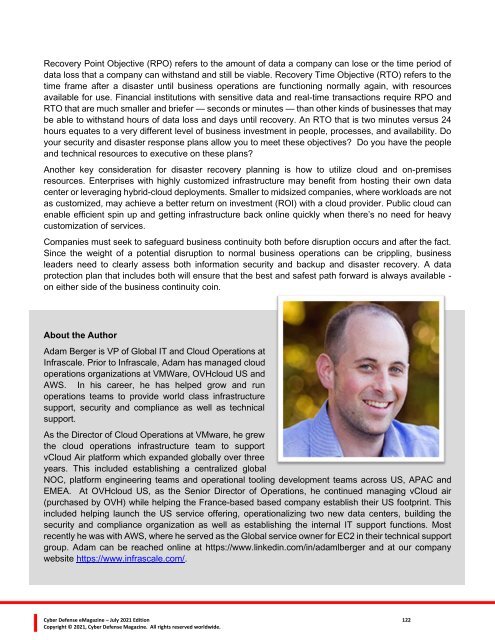Cyber Defense eMagazine July 2021 Edition
Cyber Defense eMagazine July Edition for 2021 #CDM #CYBERDEFENSEMAG @CyberDefenseMag by @Miliefsky a world-renowned cyber security expert and the Publisher of Cyber Defense Magazine as part of the Cyber Defense Media Group as well as Yan Ross, US Editor-in-Chief, Pieruligi Paganini, Co-founder & International Editor-in-Chief, Stevin Miliefsky, President and many more writers, partners and supporters who make this an awesome publication! Thank you all and to our readers! OSINT ROCKS! #CDM #CDMG #OSINT #CYBERSECURITY #INFOSEC #BEST #PRACTICES #TIPS #TECHNIQUES
Cyber Defense eMagazine July Edition for 2021 #CDM #CYBERDEFENSEMAG @CyberDefenseMag by @Miliefsky a world-renowned cyber security expert and the Publisher of Cyber Defense Magazine as part of the Cyber Defense Media Group as well as Yan Ross, US Editor-in-Chief, Pieruligi Paganini, Co-founder & International Editor-in-Chief, Stevin Miliefsky, President and many more writers, partners and supporters who make this an awesome publication! Thank you all and to our readers! OSINT ROCKS! #CDM #CDMG #OSINT #CYBERSECURITY #INFOSEC #BEST #PRACTICES #TIPS #TECHNIQUES
Create successful ePaper yourself
Turn your PDF publications into a flip-book with our unique Google optimized e-Paper software.
Recovery Point Objective (RPO) refers to the amount of data a company can lose or the time period of<br />
data loss that a company can withstand and still be viable. Recovery Time Objective (RTO) refers to the<br />
time frame after a disaster until business operations are functioning normally again, with resources<br />
available for use. Financial institutions with sensitive data and real-time transactions require RPO and<br />
RTO that are much smaller and briefer — seconds or minutes — than other kinds of businesses that may<br />
be able to withstand hours of data loss and days until recovery. An RTO that is two minutes versus 24<br />
hours equates to a very different level of business investment in people, processes, and availability. Do<br />
your security and disaster response plans allow you to meet these objectives? Do you have the people<br />
and technical resources to executive on these plans?<br />
Another key consideration for disaster recovery planning is how to utilize cloud and on-premises<br />
resources. Enterprises with highly customized infrastructure may benefit from hosting their own data<br />
center or leveraging hybrid-cloud deployments. Smaller to midsized companies, where workloads are not<br />
as customized, may achieve a better return on investment (ROI) with a cloud provider. Public cloud can<br />
enable efficient spin up and getting infrastructure back online quickly when there’s no need for heavy<br />
customization of services.<br />
Companies must seek to safeguard business continuity both before disruption occurs and after the fact.<br />
Since the weight of a potential disruption to normal business operations can be crippling, business<br />
leaders need to clearly assess both information security and backup and disaster recovery. A data<br />
protection plan that includes both will ensure that the best and safest path forward is always available -<br />
on either side of the business continuity coin.<br />
About the Author<br />
Adam Berger is VP of Global IT and Cloud Operations at<br />
Infrascale. Prior to Infrascale, Adam has managed cloud<br />
operations organizations at VMWare, OVHcloud US and<br />
AWS. In his career, he has helped grow and run<br />
operations teams to provide world class infrastructure<br />
support, security and compliance as well as technical<br />
support.<br />
As the Director of Cloud Operations at VMware, he grew<br />
the cloud operations infrastructure team to support<br />
vCloud Air platform which expanded globally over three<br />
years. This included establishing a centralized global<br />
NOC, platform engineering teams and operational tooling development teams across US, APAC and<br />
EMEA. At OVHcloud US, as the Senior Director of Operations, he continued managing vCloud air<br />
(purchased by OVH) while helping the France-based based company establish their US footprint. This<br />
included helping launch the US service offering, operationalizing two new data centers, building the<br />
security and compliance organization as well as establishing the internal IT support functions. Most<br />
recently he was with AWS, where he served as the Global service owner for EC2 in their technical support<br />
group. Adam can be reached online at https://www.linkedin.com/in/adamlberger and at our company<br />
website https://www.infrascale.com/.<br />
<strong>Cyber</strong> <strong>Defense</strong> <strong>eMagazine</strong> – <strong>July</strong> <strong>2021</strong> <strong>Edition</strong> 122<br />
Copyright © <strong>2021</strong>, <strong>Cyber</strong> <strong>Defense</strong> Magazine. All rights reserved worldwide.


















